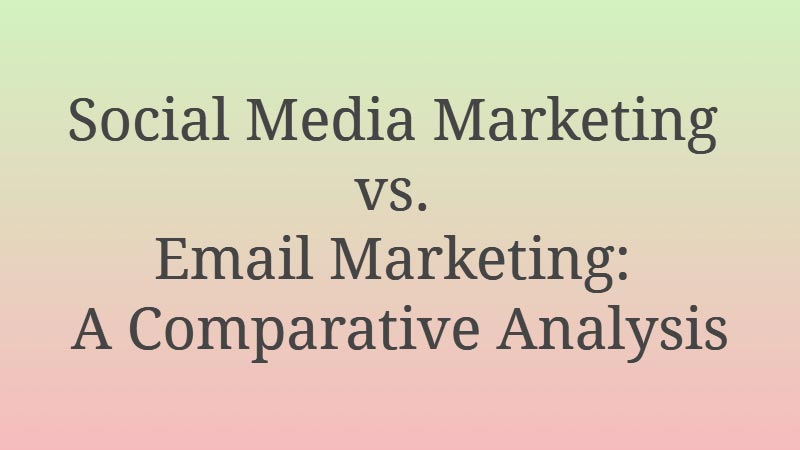Know the merits and demerits of Social Media Marketing vs. Email marketing which one is better and which one to choose.
Social media marketing and email marketing are two popular digital marketing strategies that businesses employ to reach their target audience and promote their products or services. Both approaches have unique advantages and limitations, and their effectiveness varies depending on the business type, objectives, and target audience.
Besides, this comprehensive analysis will compare the two marketing methods, examining their strengths, weaknesses, best practices, and overall effectiveness. Overall, by exploring the benefits and challenges of each approach, businesses can make informed decisions to integrate the most suitable strategy into their marketing campaigns.
In today’s digital age, marketing has evolved significantly, with businesses relying heavily on online channels to connect with their audience. Social media marketing and email marketing have emerged as two essential pillars of modern digital marketing.
Although, both strategies enable businesses to establish and maintain relationships with their customers, generate leads, and drive sales. However, determining which approach is better depends on various factors, including the specific marketing goals, target audience, and resources available.
Finally, by the end, readers will have a deeper understanding of each strategy’s potential, enabling them to make informed choices about incorporating the most suitable marketing method into their campaigns.
Social Media Marketing
1.1 Definition of Social Media Marketing:
Social media marketing refers to the use of social media platforms to promote a brand, engage with the target audience, and drive desired actions such as purchases or sign-ups. Popular social media platforms include Facebook, Instagram, Twitter, LinkedIn, and others.
In addition, this strategy leverages the vast user base and engagement opportunities provided by these platforms to increase brand visibility and foster meaningful interactions. Above all, there are multiple ways where you can promote your website on social media.
1.2 Advantages of Social Media Marketing:
a) Wider Reach: Social media platforms boast billions of active users worldwide, making them an ideal channel to reach a large audience.
b) Targeted Advertising: These platforms offer robust targeting options, allowing businesses to focus on specific demographics, interests, and behaviors.
c) Engagement and Interaction: Social media enables direct interactions with customers, fostering engagement and building brand loyalty.
d) Rich Media Content: Businesses can use various media formats (images, videos, GIFs) to create engaging content and communicate their message effectively.
1.3 Limitations of Social Media Marketing:
a) Algorithm Changes: Social media algorithms are constantly evolving, impacting organic reach and engagement for businesses.
b) Competition and Noise: The high volume of content shared on social media can make it challenging for businesses to stand out.
c) Platform Dependency: Businesses rely on third-party platforms, and any changes or shutdowns can disrupt marketing efforts.
d) Limited Conversion Tracking: Attribution and conversion tracking on social media can be more challenging than email marketing.
1.4 Best Practices for Social Media Marketing:
a) Consistent Brand Voice: Maintain a consistent brand voice across all social media platforms to reinforce brand identity.
b) Engaging Content: Share valuable and engaging content that resonates with the target audience.
c) Use Visuals: Utilize eye-catching visuals to capture attention and enhance engagement.
d) Two-Way Communication: Respond promptly to comments, messages, and mentions to foster a sense of community.
e) Analyze Performance: Regularly analyze social media insights to refine strategies and identify opportunities for improvement.
Email Marketing
2.1 Definition of Email Marketing:
Email marketing involves sending targeted messages directly to a group of recipients via email. Basically, it is a permission-based marketing strategy, where subscribers voluntarily sign up to receive updates, promotions, or newsletters from a brand.
Email marketing is often used for lead nurturing, customer retention, and direct sales. Similarly, there are Email Marketing services that you can use to run your marketing campaign.
2.2 Advantages of Email Marketing:
a) Personalized Communication: Email allows businesses to send personalized messages based on user preferences and behavior, increasing relevance and engagement.
b) Direct Access to Audience: Email reaches subscribers directly in their inbox, offering a higher chance of visibility and engagement.
c) Trackable Metrics: Email marketing platforms provide detailed analytics, enabling businesses to measure the effectiveness of campaigns.
d) Automation Capabilities: Automation tools can streamline email marketing campaigns, saving time and effort.
2.3 Limitations of Email Marketing:
a) Deliverability Issues: Emails may end up in spam folders, reducing their chances of being seen by recipients.
b) List Management: Keeping email lists up-to-date and relevant can be challenging, as subscribers’ interests and preferences change over time.
c) Email Overload: With the abundance of emails individuals receive daily, competition for attention is high, and email fatigue is a concern.
d) Design Constraints: Emails need to be designed carefully to ensure they display correctly across various devices and email clients.
2.4 Best Practices for Email Marketing:
a) Segmentation: Divide the email list into segments based on demographics, behavior, or engagement level to deliver targeted content.
b) Personalization: Use dynamic content and personalized greetings to enhance engagement and relevance.
c) Clear Call-to-Action (CTA): Ensure that emails have clear and compelling CTAs to encourage desired actions.
d) A/B Testing: Test different email elements (subject lines, content, CTAs) to optimize campaign performance.
e) Optimize for Mobile: Design emails to be mobile-friendly, as a significant portion of recipients open emails on mobile devices.
Comparative Analysis and Effectiveness
3.1 Target Audience:
The effectiveness of both social media marketing and email marketing largely depends on the target audience. After all, younger demographics may be more active on social media platforms like Instagram and Snapchat, while professionals and businesses are more likely to engage through email.
Moreover, a comprehensive understanding of the target audience’s preferences and behaviors is crucial in deciding which strategy to prioritize.
3.2 Conversion Rates:
Email marketing often outperforms social media marketing in terms of conversion rates. Since email communication is more direct and personalized, subscribers are more likely to take the desired action. However, social media plays a vital role in driving traffic to websites, which can complement email marketing efforts.
3.3 Engagement and Interactivity:
Social media marketing excels in engagement and interactivity. The nature of social media platforms encourages conversations and direct interactions with followers, enabling businesses to build stronger relationships. On the other side, email marketing, while personalized, lacks the real-time engagement opportunities that social media provides.
3.4 Cost and Return on Investment (ROI):
Social media marketing can be more cost-effective, especially for businesses with limited budgets, as setting up profiles and organic content creation is relatively inexpensive. On the other hand, email marketing platforms may incur subscription costs, but their high ROI potential compensates for the investment.
3.5 Brand Visibility and Awareness:
Social media marketing plays a crucial role in increasing brand visibility, as businesses can reach a broader audience and gain exposure through shares and viral content. Email marketing focuses on strengthening relationships with existing customers, which can lead to increased brand loyalty and referrals.
Types of Social Media Marketing

Social media marketing encompasses various strategies and techniques that businesses and individuals use to promote their products, services, or personal brands on social media platforms.
Here are some common types of social media marketing:
Content Marketing: Creating and sharing valuable and relevant content (such as blog posts, articles, videos, infographics, etc.) on social media platforms to attract and engage the target audience. The content aims to provide value, entertain, educate, or solve problems for users, thereby building brand awareness and loyalty.
Influencer Marketing: Collaborating with influencers or individuals with a substantial following on social media to promote products or services. Influencers can help reach a broader audience, increase credibility, and create more authentic connections with potential customers.
Social Media Advertising: Paid advertising on social media platforms, where businesses can target specific demographics, interests, behaviors, and locations to reach their ideal audience. Common social media ad formats include sponsored posts, carousel ads, video ads, and story ads.
Social Media Contests and Giveaways: Running contests or giveaways on social media platforms to increase engagement, attract new followers, and reward loyal customers. Contests may involve user-generated content, sharing, or participation to enter.
Community Management: Engaging with the social media audience by responding to comments, messages, and mentions promptly. Building a strong online community fosters trust, customer loyalty, and positive brand perception.
Social Listening: Monitoring social media platforms for mentions, discussions, and sentiments related to the brand or industry. Social listening helps businesses understand their audience better, track competitors, and address customer concerns proactively.
User-Generated Content (UGC) Campaigns: Encouraging users to create and share content related to the brand or products. UGC can be a powerful tool to showcase real customer experiences, improve authenticity, and build social proof.
Live Streaming: Broadcasting live videos on social media platforms to interact with the audience in real time. Live streaming can be used for product launches, Q&A sessions, behind-the-scenes glimpses, and events.
Social Media Influencer Takeovers: Allowing influencers to take over a brand’s social media account for a specific period to create content and engage with their followers. This collaboration can boost brand awareness and reach new audiences.
Social Media Analytics and Insights: Analyzing social media data and metrics to measure the effectiveness of marketing efforts, identify trends, and make data-driven decisions for future strategies.
The choice of social media marketing types depends on the specific goals, target audience, and resources available to a business or individual. An effective social media marketing strategy often combines several of these approaches to achieve the best results.
Types of Email Marketing

Email marketing is a powerful digital marketing strategy that involves sending commercial messages to a group of people via email. There are various types of email marketing campaigns that businesses and organizations can use to engage with their audience and achieve different marketing objectives.
Here are some common types of email marketing:
Promotional Emails: These emails are sent to promote a specific product, service, or offer. Besides, they aim to drive sales, encourage sign-ups, or increase website traffic. Promotional emails often include discounts, limited-time offers, or new product announcements.
Newsletter Emails: Newsletter emails are regular updates sent to subscribers with relevant and valuable content. Basically, they can include industry news, company updates, blog posts, curated content, and more. The goal is to keep subscribers informed and engaged with your brand.
Welcome Emails: When someone subscribes to your email list, a welcome email is sent to greet them and provide essential information about your brand or services. In addition to that, Welcome emails are crucial for making a positive first impression and building a strong relationship with new subscribers.
Abandoned Cart Emails: These emails target customers who added items to their shopping cart but did not complete the purchase. Moreover, abandoned cart emails often include a reminder of the items left behind and sometimes offer incentives like discounts or free shipping to encourage customers to complete their purchases.
Transactional Emails: Transactional emails are sent in response to a specific action taken by a user, such as order confirmations, shipping notifications, password resets, and account updates. Though primarily functional, they can also be an opportunity to reinforce your brand and provide additional relevant information.
Re-engagement Emails: Re-engagement emails are sent to inactive subscribers to rekindle their interest in your brand. They might include special offers or content to entice recipients back to your website or encourage them to update their preferences.
Announcement Emails: These emails are used to share significant announcements, such as product launches, company updates, or upcoming events. They help keep your subscribers informed about exciting developments in your business.
Survey and Feedback Emails: Feedback emails are used to gather customer opinions, preferences, and feedback about your products or services. Additionally, surveys can provide valuable insights for improving your offerings and better understanding your audience.
Holiday and Seasonal Emails: These emails are themed around holidays, special occasions, or seasonal events. Furthermore, they can include holiday greetings, special offers, and gift ideas tailored to the season.
Milestone Emails: Milestone emails celebrate significant events in the customer’s journey with your brand, such as a customer’s anniversary since signing up or reaching a specific milestone in their usage.
Remember that successful email marketing campaigns should be personalized, relevant, and offer value to the recipients. Additionally, compliance with email marketing regulations, such as GDPR (General Data Protection Regulation) or CAN-SPAM Act, is essential to ensure ethical and lawful practices.
Conclusion
In conclusion, both social media marketing and email marketing are valuable components of a comprehensive digital marketing strategy. Above all, the effectiveness of each method depends on the business’s objectives, target audience, and available resources.
Furthermore, social media marketing is powerful for expanding brand reach, engaging with a broader audience, and fostering a sense of community. On the other hand, email marketing excels in personalized communication, driving conversions, and nurturing leads.
Ultimately, businesses should consider integrating both social media marketing and email marketing into their campaigns to leverage the strengths of each strategy effectively. By doing so, they can create a harmonious marketing approach that maximizes brand visibility, nurtures customer relationships, and drives sustainable business growth.
Now over to you,
Which marketing technique are you using for your WordPress website?
Did I miss any pros and cons on the social media marketing vs. email marketing comparison?
Please let us know your thoughts and follow us on Facebook and Twitter.


